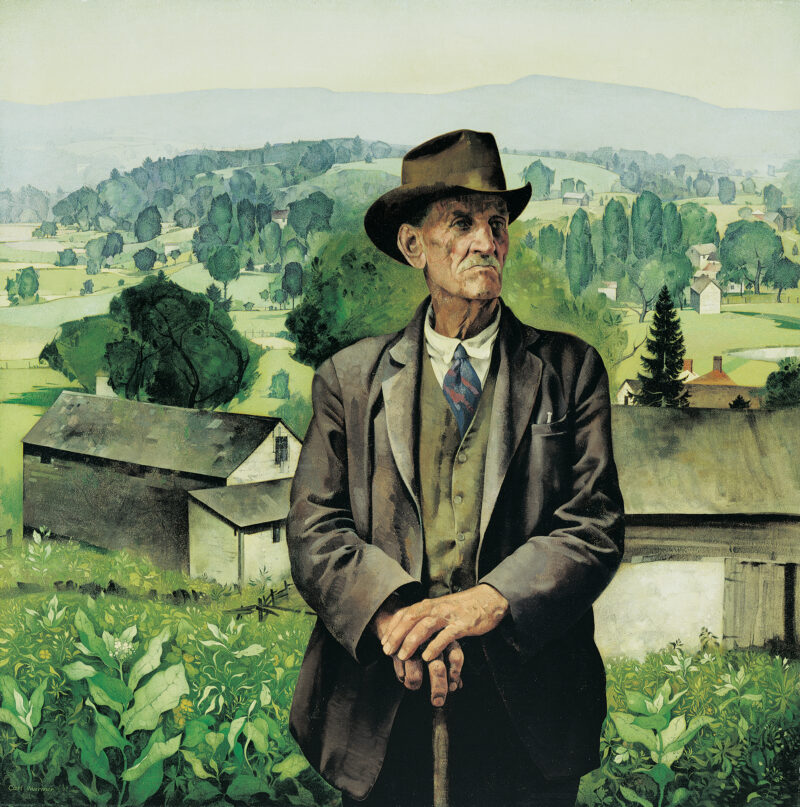
American Farmer
Wuermer, Carl
1930
Artwork Information
-
Title:
American Farmer
-
Artist:
Wuermer, Carl
-
Artist Bio:
American, 1900–1983
-
Date:
1930
-
Medium:
Oil on canvas, mounted on Masonite
-
Dimensions:
36 1/4 x 36 1/4 inches
-
Credit Line:
Wichita Art Museum, Museum purchase, Friends of the Wichita Art Museum, Volunteers of the Gift Shop
-
Object Number:
1987.6
-
Display:
Not Currently on Display
About the Artwork
Carl Wuermer’s captivating image of an American Farmer, painted in 1930, stands both as a portrait of an individual farmer and as a symbol of the common American farmer of the period. The model for the farmer was a Mr. Hommel, whom Wuermer represented standing before the sunlit hills of the Schutis farm in Woodstock, New York.1 The farmer s deeply wrinkled face, shaded gaze and softly stern expression convey a sense of the wisdom that comes with age. Likewise, his firmly rooted frame, balanced steadily over his wooden cane, adds an air of nobility to his bearing. The dignified presence of this man before the wooded fields and rolling hills speaks silently of his pride in his past—of both happy achievements and sorrowful struggles in toiling the land. From his gnarled, calloused hands to the rich, earthy tones in which he is clothed, Wuermer’s American Farmer seems to embody the spirit of the land.
But the farm now lies behind him, and his eyes peer out with uncertainty into the distance of a less assured future. By 1930 the Great Depression had begun, and this farmer’s ambiguous gaze seems to point toward the unknown future with worry and determination.2 In this respect, Wuermer’s figure stands as a symbol of every American farmer of the 1930s whose economic future in the land was at stake. In addition to the generic title of this portrait, the schism between Wuermer’s representation of the figure and its background landscape contributes to the symbolic nature of American Farmer. The farmer appears almost as a cut-out figure standing before a previously-painted backdrop. He seems to stand before rather than within the landscape. The marked, Byzantine-like detachment of the figure from its environment effectively seals off the farmer from the land before which he proudly stands. Is Wuermer placing this individual before a nostalgic representation of a farm now obliterated by the Depression, or is this a premonition of misfortune to come? The uncertain destiny of the land with which the farmer seems to identify is inherent in the painting; it is a destiny that this man seems ready to accept with both work-worn weariness and an unwavering air of dignity. Wuermer’s American Farmer begs association with every American farmer of the Great Depression—fearful, yet steadfast in his identification with and dependence upon the bounty of his soil in this tragic era of the nation’s history.
Born in Munich, Germany in 1900, Wuermer immigrated to the United States in 1915 and became a citizen shortly thereafter. After studying at the Art Institute of Chicago from 1920-24, he traveled to New York to study at the Art Students League and then settled in Woodstock, where he lived until his death in 1983. The rural atmosphere of upstate New York provided the artist with inspiration throughout his life, in what one critic called “infinitely patient and peaceful studies of Woodstock town and country,”3 of which the Wichita Art Museum’s American Farmer is a poignant example.
1. Howard E. Wooden, Collected Essays on 101 Art Works from the Permanent Collections of the Wichita Art Museum (Wichita: Wichita Art Museum, 1988), 100.
2. Ibid.
3. “Fifty-Seventh Street in Review,” Art Digest 21 (1 March 1947): 22.